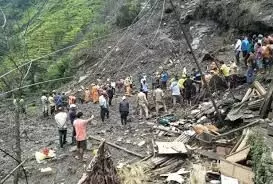A Month After June 30 Disaster: Experts Blame Human Activity for Mandi’s Monsoon Devastation
A month after cloudbursts devastated Himachal's Mandi district, experts blame unregulated construction and climate change for worsening the monsoon tragedy.
Aftermath of the Mandi monsoon disaster: Homes buried, lives lost, and questions raised about human impact on the fragile Himalayan ecosystem.

A month after devastating cloudbursts ripped through Himachal Pradesh’s Mandi district on June 30, killing dozens and displacing hundreds, experts now say man-made factors played a significant role in worsening the disaster.
On Monday night, fresh flash floods triggered by 198.6 mm of rainfall inundated several parts of Mandi, killing three people, including a mother-son duo, and damaging over two dozen houses. The torrential downpour flooded the Sukati nullahs, which carried heavy debris through the city and surrounding areas.
🔴 Human Toll and Damage
Among the deceased were Balbir Singh, Amarpreet Singh, and his mother Sapna. Amarpreet’s father, Darshan Singh, was injured and is being treated at Mandi Zonal Hospital. Officials confirmed over a dozen people were rescued, while many others were relocated to relief camps like Vipasha Sadan or sheltered with friends and relatives.
More than 20 vehicles were buried under mudslides, and widespread waterlogging affected key areas within a five-kilometre radius.
🌧️ Flashback to June 30: What Happened?
On the night of June 30, a series of at least 12 cloudbursts struck the district within 90 minutes, impacting four Assembly constituencies and devastating over 20 hectares of land. The State Disaster Management Authority (SDMA) recorded a dramatic rise in water levels across five seasonal rivulets, with their width expanding from a few feet to over 45 metres, destroying homes far from the streambeds.
The worst-affected areas included Bagsiad, Bagchanogi, Jhanjheli, Thunag, Dharampur, Karsog, and Gohar.
“Mandi has become the epicentre of monsoon disasters in Himachal Pradesh over the past three years,” said D.C. Rana, General Secretary of the SDMA. “Its location in the Mid-Himalayan zone makes it vulnerable during early monsoon periods.”
🧬 DNA Uncertainty: Families Still Await Closure
24 bodies have been recovered since the June 30 disaster, while 27 people remain missing. Among the dead, 10 bodies remain unidentified, and DNA results have matched just one body so far — Parwati Devi, 47, from Pangliyur village.
Many families, including those in village Deji, are left in agony. Eleven residents, including five children, were washed away, and DNA samples collected from grieving families have failed to match the recovered bodies.
“We performed last rites without confirmation,” said Hem Singh, who lost his daughter and three granddaughters.
🏚️ Widespread Destruction
- 500+ homes were completely destroyed
- 1,000 homes declared uninhabitable
- 300+ cattle swept away
- 254 roads blocked (176 in rural areas)
- 172 power lines down, 89 water schemes disrupted
⚠️ Man-Made Factors to Blame?
Environmentalists say the disaster is not just nature’s fury.
“Clogged natural drainage paths due to construction debris and waste dumping have turned nullahs into death traps,” said activist Guman Singh. “Unregulated development is disrupting water flow. Water will always find its way — and it does so violently when blocked.”
Singh also highlighted the role of global warming and intensifying weather patterns, warning that disasters will only increase unless infrastructure is planned with ecological sensitivity.
Kulbhushan Upmanyu, president of Himalaya Niti Abhiyan, echoed the concern, pointing to mega hydropower projects and reckless development as contributors to the ecological fragility.
“I'm not against development, but our approach must account for the unique topography and climate vulnerabilities of the Himalayas,” he said.
🕵️♂️ Centre Orders High-Level Probe
Union Home Minister Amit Shah has ordered a comprehensive investigation into the June 30 disaster. A high-level committee will probe the causes and assess lapses in disaster preparedness.
Since 2018, Himachal Pradesh has recorded:
- 148 cloudbursts
- 294 flash floods
- 5,000+ landslides
In 2024, Mandi topped the list of landslide-affected districts with nine major incidents, followed by Shimla and Kinnaur.
🧭 The Road Ahead
Experts urge scientific urban planning, stricter environmental norms, and robust disaster mitigation systems. As climate change reshapes weather patterns in the fragile Himalayas, the need for resilient and sustainable development has never been more urgent.

